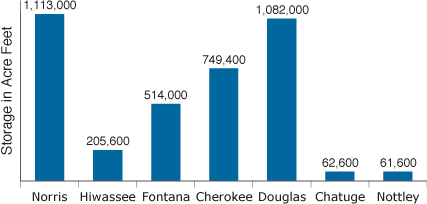Flood Storage
The space allocated for flood storage in the TVA reservoir system varies with the time of year and potential flood threat. From January 1 through March 15, the system has the capacity to store about 11 million acre-feet of water. That’s a volume equal to one foot of water covering 11 million acres of land. A capacity of about 5 million acre-feet is maintained during summer to reduce flooding caused by summer storms.
Flood storage above Chattanooga
The reservoir system in the eastern Tennessee Valley was primarily planned to protect Chattanooga from flooding. At least one reservoir was built on each of the five major tributary rivers above Chattanooga with enough space to store floodwaters from large storms in the drainage areas above them.
These seven reservoirs do the main work in controlling floods:
- Norris Reservoir on the Clinch River
- Fontana Reservoir on the Little Tennessee River
- Douglas Reservoir on the French Broad River
- Cherokee Reservoir on the Holston River
- Chatuge, Nottely and Hiwassee reservoirs in the Hiwassee River basin.
Targeted Flood Storage above Chattanooga, January 1

Three main-river reservoirs above Chattanooga–Fort Loudoun/Tellico, Watts Bar and Chickamauga–provide additional, limited storage capacity.
Together, all TVA reservoir above Chattanooga can store about 5 million acre-feet of water during the winter flood season.
Flood storage below Chattanooga
Kentucky Reservoir, near the mouth of the Tennessee River, has 4 million acre-feet of flood storage space during the winter and early spring. This represents more than 40 percent of the flood storage in the entire TVA reservoir system. This capacity can be used to reduce flood crests on the Mississippi River at Cairo, Ill., by as much as two to three feet. Learn more about averting flood damages on the Ohio and Mississippi rivers.
Three other main-river reservoirs upstream from Kentucky but below Chattanooga—Pickwick, Wheeler and Guntersville—provide about 1 million acre-feet of storage space. This is used to supplement storage in Kentucky Reservoir and to reduce flooding immediately below these dams.
Storage space in main-river reservoirs is limited by topography and the requirement in the TVA Act for a 9-foot waterway for commercial navigation from the beginning of the Tennessee River at Knoxville, Tenn., to its mouth at Paducah, Ky.